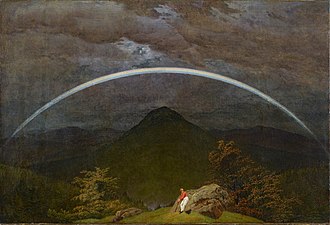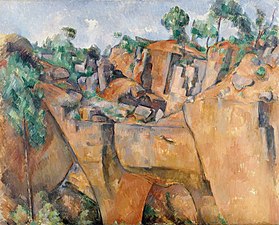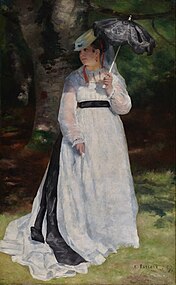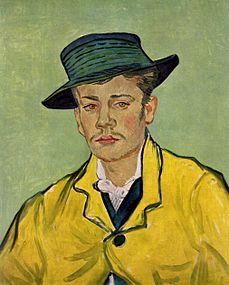
Essen is the central and, after Dortmund, second-largest city of the Ruhr, the largest urban area in Germany. Its population of 579,432 makes it the fourth-largest city of North Rhine-Westphalia after Cologne, Düsseldorf and Dortmund, as well as the ninth-largest city of Germany. Essen lies in the larger Rhine-Ruhr metropolitan region, second largest by GDP in the EU, and is part of the cultural area of Rhineland. Because of its central location in the Ruhr, Essen is often regarded as the Ruhr's "secret capital". Two rivers flow through the city: the Emscher in the north, and in the south the Ruhr River, which is dammed in Essen to form the Lake Baldeney (Baldeneysee) and Lake Kettwig reservoirs. The central and northern boroughs of Essen historically belong to the Low German (Westphalian) language area, and the south of the city to the Low Franconian Bergish area.

Degenerate art was a term adopted in the 1920s by the Nazi Party in Germany to describe modern art. During the dictatorship of Adolf Hitler, German modernist art, including many works of internationally renowned artists, was removed from state-owned museums and banned in Nazi Germany on the grounds that such art was an "insult to German feeling", un-German, Freemasonic, Jewish, or Communist in nature. Those identified as degenerate artists were subjected to sanctions that included being dismissed from teaching positions, being forbidden to exhibit or to sell their art, and in some cases being forbidden to produce art.

Henry Clemens van de Velde was a Belgian painter, architect, interior designer, and art theorist. Together with Victor Horta and Paul Hankar, he is considered one of the founders of Art Nouveau in Belgium. He worked in Paris with Siegfried Bing, the founder of the first gallery of Art Nouveau in Paris. Van de Velde spent the most important part of his career in Germany and became a major figure in the German Jugendstil. He had a decisive influence on German architecture and design at the beginning of the 20th century.
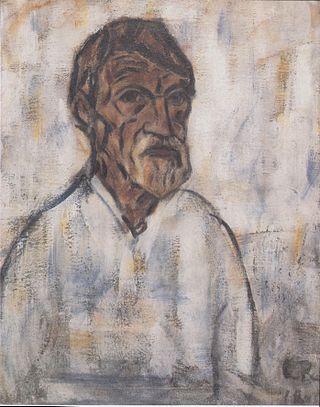
Christian Rohlfs was a German painter and printmaker, one of the important representatives of German expressionism.
The "Sonderbund" — as it is normally called; its complete name being Sonderbund westdeutscher Kunstfreunde und Künstler, and also known as Sonderbund group — was a "special union" of artists and art lovers, established 1909 in Düsseldorf and dissolved in 1916. In its first years, the Sonderbund mounted some landmark exhibitions, successfully introducing French Impressionist, Post-Impressionist and Modern Art to the western parts of Germany.

Karl Ernst Osthaus was an important German patron of avant-garde art and architecture.

The Karl Ernst Osthaus-Museum is an art museum in Hagen, North Rhine-Westphalia, Germany. The center of the museum is a building whose interior was designed by Henry van de Velde to house Karl Ernst Osthaus' art collection, open to the public as the Museum Folkwang. When Osthaus' heirs sold his art collection to the city of Essen, the city of Hagen gained possession of the empty museum building. For a time it served as offices for the local electric company.

The Kunsthaus Zürich is in terms of area the biggest art museum of Switzerland and houses one of the most important art collections in Switzerland, assembled over time by the local art association called Zürcher Kunstgesellschaft. The collection spans from the Middle Ages to contemporary art, with an emphasis on Swiss art.
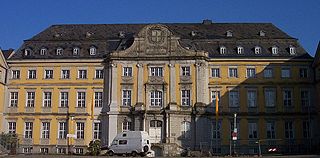
The Folkwang University of the Arts is a university for music, theater, dance, design, and academic studies, located in four German cities of North Rhine-Westphalia. Since 1927, its traditional main location has been in the former Werden Abbey in Essen in the Ruhr area, with additional facilities in Duisburg, Bochum, and Dortmund, and, since 2010, at the Zeche Zollverein, a World Heritage Site also in Essen. The Folkwang University is home to the international dance company Folkwang Tanz Studio (FTS). Founded as Folkwangschule, its name was Folkwang Hochschule from 1963 until 2009.

Bathers with a Turtle is a painting by Henri Matisse from 1907 to 1908, in the collection of the Saint Louis Art Museum in St. Louis, Missouri. In 1908 it has been acquired by Karl Ernst Osthaus who included it into the Folkwang Museum in Hagen, Germany. It was removed from being exhibited by the Nazis in 1937 and brought to Niederschönhausen Palace. It was purchased for $2400 by Joseph Pulitzer Jr. in 1939 at an auction of art that the Nazi government considered "degenerate". The socalled "Degenerate Art auction" took place in the Grand Hotel National in Lucerne, Switzerland. Pulitzer purchased it at the urging of Matisse's son Pierre Matisse, in order to prevent the artwork from being destroyed, despite the profit from the auction going to the Nazis. Pulitzer later donated it to the art museum in Saint Louis.

The Alfried Krupp von Bohlen und Halbach Foundation is a major German philanthropic foundation, created by and named in honor of Alfried Krupp von Bohlen und Halbach, former owner and head of the Krupp company and a convicted war criminal.
Heinrich Brocksieper was a German photographer, experimental filmmaker and painter who was educated at the Bauhaus design school.
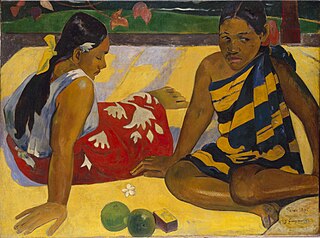
The Galerie Neue Meister in Dresden, Germany, displays around 300 paintings from the 19th century until today, including works from Otto Dix, Edgar Degas, Vincent van Gogh and Claude Monet. The gallery also exhibits a number of sculptures from the Dresden Sculpture Collection from the same period. The museum's collection grew out of the Old Masters Gallery, for which contemporary works were increasingly purchased after 1843.

Will Lammert was a German sculptor. In 1959 he was posthumously awarded the National Prize of the German Democratic Republic.

Portrait of Vincent Nubiola is an oil painting by Spanish artist Joan Miró. Painted in 1917 when Miró was 24 years old, a year before his first exhibition, the portrait is now considered a masterpiece from a period when he experimented with both Cubism and Fauvism. It is also said by some art critics to show the influence of Van Gogh. Acquired for a time by Picasso, the painting is now in the permanent collection of the Folkwang Museum in Essen (Germany).

Ulrich Blank is a doctor of industrial engineering in Essen, Germany. He was for many years CEO of Heinrich Industrie AG and was a member of various supervisory boards and advisory boards of family businesses. In September 2018, he was awarded the Cross of Merit of the Federal Republic of Germany for his many years of voluntary work in the cultural field, in particular in favor of the Museum Folkwang. In September 2023, Ulrich Blank was awarded the Medal of Merit of the City of Essen.
Ernst Henke was a German lawyer and company manager.
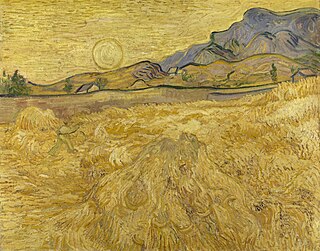
Reaper, Wheat Field with Reaper, or Wheat Field with Reaper and Sun is the title given to each of a series of three oil-on-canvas paintings by Vincent van Gogh of a man reaping a wheat field under a bright early-morning sun. To the artist, the reaper represented death and "humanity would be the wheat being reaped". However, Van Gogh did not consider the work to be sad but "almost smiling" and taking "place in broad daylight with a sun that floods everything with a light of fine gold".
Max Creutz was a German art historian and curator of the Museum für Angewandte Kunst Köln and the Kaiser-Wilhelm-Museum in Krefeld where he worked from 1922 until his death. In Cologne, in 1914 he was instrumental in the first exhibition of the Deutscher Werkbund, Deutsche Werkbundausstellung. In Krefeld, he succeeded in acquiring modern art exhibits, including works by Max Ernst, Wassily Kandinsky, and Alexej von Jawlensky. He included a substantial collection of art, crafts and design from the Bauhaus.

The Duchess of Montesquiou-Fezensac is a 1910 oil portrait by Oskar Kokoschka. In this expressionist work Kokoschka strove to capture the essence of his sitter, a young noblewoman afflicted with tuberculosis, with somber tones and stylized gestures. Among his early portraits, Kokoschka considered the work his most valuable, and as his first work to be acquired by a museum it played a key role in establishing the young artist's reputation. During the Nazi period it was confiscated from the Museum Folkwang in Essen and pilloried in the Degenerate Art exhibition before being auctioned off. It is currently in the collection of the Cincinnati Art Museum.





